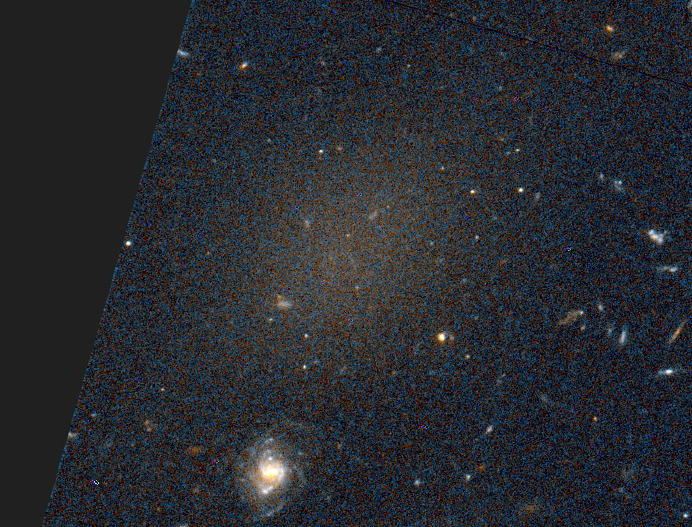







| BOOKS | F. A. Q. | ARTICLES | TALKS | ABOUT KEN | DONATE | BEYOND OUR KEN |
|---|
By Ken Croswell
Published in Scientific American (April 2015)

Ultradiffuse galaxies, such as this one in the Coma cluster, are pale, ghostly, and large.
Credit: Hubble Space Telescope. NASA, ESA, and Pieter van Dokkum (Yale University) et al.
The word �galaxy� derives from the Greek for �milky,� but some such celestial systems look more like extremely skim milk. A new array of small telescopes has serendipitously discovered 47 �ultradiffuse� galaxies whose stars are so spread out from one another that they appear ghostly pale. Several of them are as large as our own, but each is much fainter, bearing roughly 1,000th as many stars as the Milky Way. No one knows how such odd galaxies originated.
The phantom galaxies materialized to astronomers after they deployed Dragonfly, an array in New Mexico composed of eight Canon telephoto lenses. �We just couldn't resist looking at Coma,� says Roberto Abraham, an astronomer at the University of Toronto, referring to a rich galaxy cluster in the constellation Coma Berenices. The cluster houses thousands of galaxies 340 million light-years from Earth and has a storied legacy: in the 1930s astronomers first detected dark matter there.
Dragonfly's Coma image did not disappoint. On it, Abraham and his colleagues saw faint smudges indicative of large, diffuse galaxies. By luck, the Hubble Space Telescope had captured one of them during an unrelated observation, providing more detail. The galaxies, it reveals, look nothing like our own. Instead they are smooth, round, and devoid of any gas to form new stars, and although the objects resemble diffuse galaxies known as dwarf spheroidals, they are anything but small. The discovery is described in the January 20, 2015, issue of The Astrophysical Journal Letters.
How did such bizarre and difficult-to-detect galaxies arise? Team member Pieter van Dokkum, an astronomer at Yale University, suspects the galaxies may be failed Milky Ways�big galaxies that were headed for brilliance but lost their gas before forming many stars, perhaps because supernova explosions catapulted gas out of the galaxies and into the parent Coma cluster. They also must harbor lots of dark matter to hold together; otherwise the gravitational pull of other galaxies in the cluster would rip them apart.
Exactly how much dark matter they possess is unknown because no one has yet achieved the feat of measuring their mass. Nevertheless, �they're great dark matter labs,� says Chris Impey, an astronomer at the University of Arizona. If dark matter emits radiation, these galaxies could be the place to see it.
Ken Croswell earned his Ph.D. in astronomy from Harvard University and is the author of The Alchemy of the Heavens and The Lives of Stars.
"An engaging account of the continuing discovery of our Galaxy...wonderful." --Owen Gingerich, The New York Times Book Review. See all reviews of The Alchemy of the Heavens here.
"A stellar picture of what we know or guess about those distant lights."--Kirkus. See all reviews of The Lives of Stars here.
| BOOKS | F. A. Q. | ARTICLES | TALKS | ABOUT KEN | DONATE | BEYOND OUR KEN |
|---|